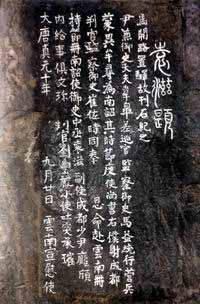 Yuan Zi (749-818) was named Deshen. The Old Book of Tang states that he was from Runan, Chen County (now Runan, Henan Province), and the New Book of Tang says he was from Langshan, Caizhou. Brother-in-law Yuan Jie. He was introduced to officials by recommendation, and he first taught the examination and proofreading book. Later, he became the Prime Minister of Xianzong, and finally he was appointed as the Hunan Observer Envoy. The biography of "Old Book of Tang Dynasty" said that Yuan Zi "worked in seal script and had great elegance." Ye Changchi's "Yu Shi" said: "Li Yangbing is the most popular seal script in the Tang Dynasty... At the same time, Yuan Zi and Qu Lingwen were three in number." "There are very few handwritings of Yuan Zi, who once served as envoy to Nanzhao. There are still some cliff carvings of his inscriptions in Yanjin, Zhaotong, which are very precious.
Yuan Zi (749-818) was named Deshen. The Old Book of Tang states that he was from Runan, Chen County (now Runan, Henan Province), and the New Book of Tang says he was from Langshan, Caizhou. Brother-in-law Yuan Jie. He was introduced to officials by recommendation, and he first taught the examination and proofreading book. Later, he became the Prime Minister of Xianzong, and finally he was appointed as the Hunan Observer Envoy. The biography of "Old Book of Tang Dynasty" said that Yuan Zi "worked in seal script and had great elegance." Ye Changchi's "Yu Shi" said: "Li Yangbing is the most popular seal script in the Tang Dynasty... At the same time, Yuan Zi and Qu Lingwen were three in number." "There are very few handwritings of Yuan Zi, who once served as envoy to Nanzhao. There are still some cliff carvings of his inscriptions in Yanjin, Zhaotong, which are very precious.
Yuan Zi inscribed on the cliff stone carvings. Douchuan Pass, located 15 kilometers southwest of Yanjin County, is passed by National Highway 213. It is an important transportation route from Sichuan to Yunnan and an important pass in the "Five Feet Road" of Qin and Han Dynasties. On the north bank of the Guan River, there is a huge rock hanging at the Dousha Shimen Pass. In the 10th year of Zhenyuan of the Tang Dynasty (794), Yuan Zi, the censor, was ordered to go to Yunnan. He registered Yimouxun as Nanzhao. He passed by Shimen Pass to commemorate his trip and inscribed it on the cliff. The area of the cliff is 0.44×0.36 meters. From left to right, the full text is written in eight lines, each line has 3-21 characters. The seven lines on the left are regular script, and the three characters "Yuan Ziti" in the last line are seal script. According to the historical records of Massa Ya, scholars call it "a sign of ethnic friendship" and have corrected the errors in "Yunnan Chronicles Chengtu Chapter". Its book and periodical remains are rare physical materials in the southwest frontier documents. It plays an important historical role in "maintaining the unity of the country, defining the boundaries of the territory, observing the harmony of the nationalities, filling the gaps in the Tang Dynasty books, making up for the mistakes in the book, and adding to the traces of the Yuan Dynasty books". In 1963, funds were allocated to build a wind and rain pavilion to protect the cliff. In 1965, the Provincial People's Committee announced it as a provincial key cultural relic protection unit. In 1980, the Fengyu Pavilion was renovated into a steel-concrete structure, with a magnetically inlaid ridge on the top and raised cornices, making it stand tall and majestic. In January 1988, the State Council announced it as the third batch of national key cultural relics protection units. In 1995, Moya Pavilion was renovated.
Attached is the original text of Tang Dynasty Moya: "On September 20, the tenth year of Zhenyuan in the Tang Dynasty, the Yunnan Xuanwei envoy sent Ju Wenzhen to judge Liu Youyan. The envoy Tutu Chengcui held the festival book. The Nanzhao envoy Yushi Zhongcheng Yuan Zi, deputy envoy Chengdu Shaoyin Pang Qi, supervised Cui Zuo, the imperial censor, was ordered to go to Yunnan to register Yimouxun for Nanzhao. At that time, he was the envoy of the Jiedushi Shang Shu, the right servant of She Chengdu Yin. He also served as the imperial censor's doctor Wei Gao sent the inspector to supervise the censor Ma Yi. The soldiers and horses of the camp opened the road and set up a post. Yuan Zi of the Shiji. question".








